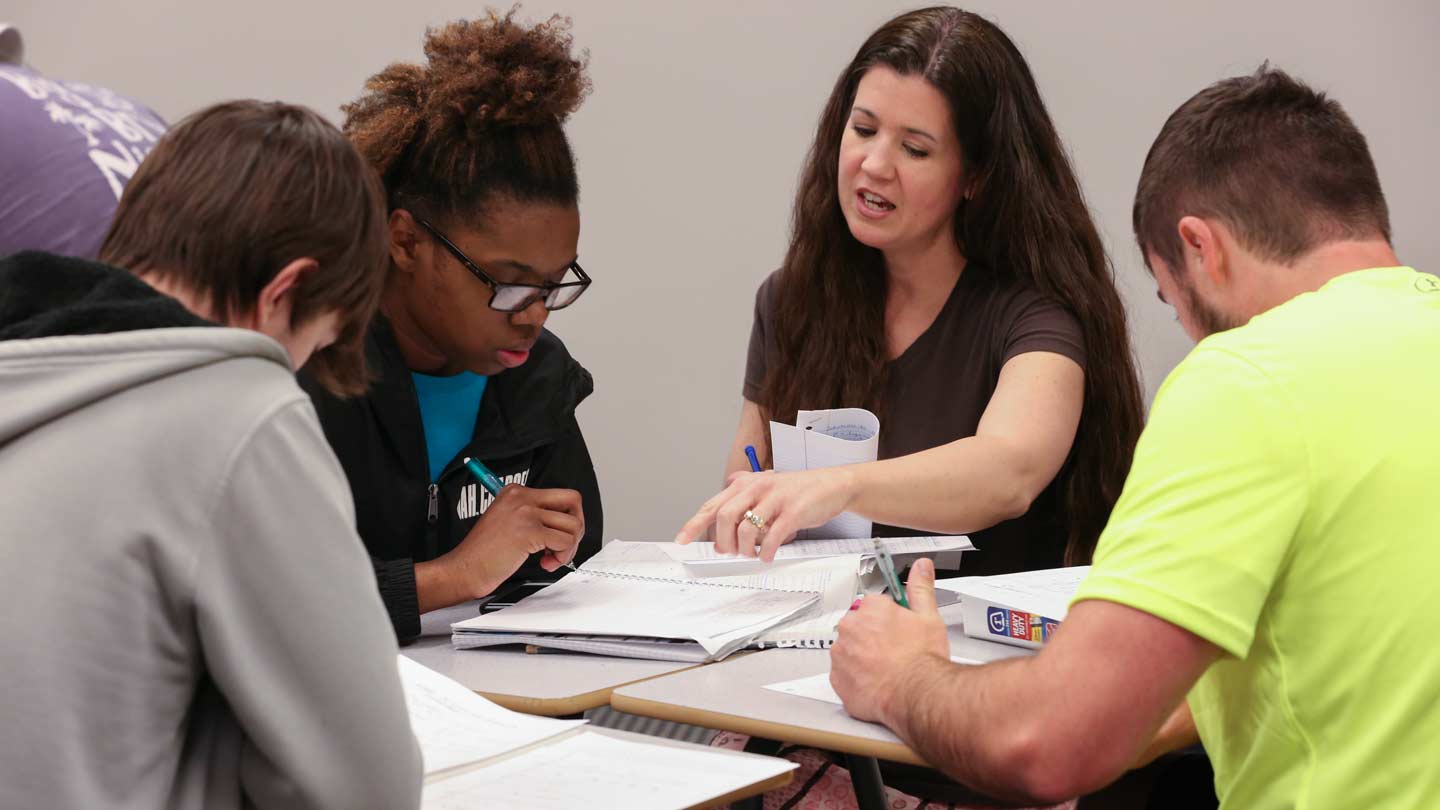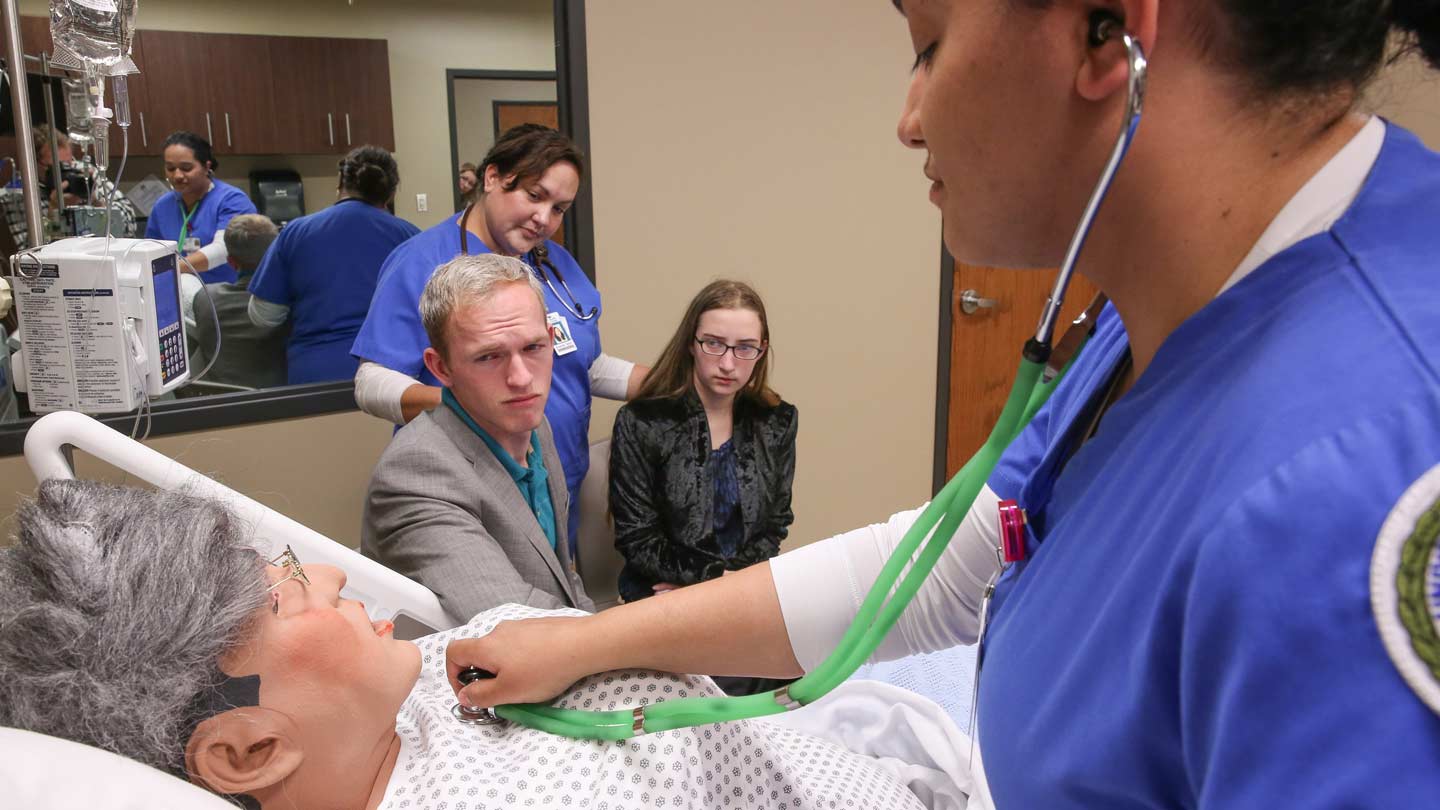
Students in Bowman’s calculus class enjoy higher success rates thanks to her inclusion of collaborative-learning techniques.
Michael Mercier | UAH
With increased recruitment efforts by The University of Alabama in Huntsville (UAH) resulting in record enrollment over the past year, the focus is now on
making sure that the university's growth is sustainable. Key to that is ensuring that all students - whether first-time freshmen, transfers,
on-campus residents, or off-campus commuters - feel connected to UAH.
"Through surveys, focus groups, and collaborative problem-solving sessions, we've learned that students who have difficulty succeeding academically often
feel isolated and disconnected from their peers," says Dr. Al Wilhite, chair of the committee appointed to improve student success and retention at UAH.
"We also discovered that those who overcame the challenges they faced did so because of the connections they made with other students."
Its mission is to develop best practices in a collaborative-learning environment and make them part of every student’s experience to improve how we teach and how students learn.
Most of those connections were made in the classroom, and in particular in classes that encouraged or required students to work together and interact.
"Classes present the best opportunity the institution has to reach all of its students," says Dr. Wilhite. "While there are other venues on campus accessed
by many students, the classroom is the only place shared by transfer students, first-time freshmen, and those at both the beginning and the end of their
academic careers."
Enter the Collaborative Learning Center (CLC), a brand-new initiative that seeks to combine classroom-based activity with enhanced learning techniques and
bring students together in an academic activity. "Its mission is to develop best practices in a collaborative-learning environment and make them part of
every student's experience to improve how we teach and how students learn," says Dr. Christine Curtis, Provost and Executive Vice President for Academic
Affairs. This will be done in accordance with the fundamental principles underlying collaborative learning:
-
Egalitarian. Everyone in the collaboration is expected to contribute, which emphasizes the value of different knowledge, perspectives, and skill sets.
-
Discursive. The involvement of all the collaborators necessitates their interaction, which opens their horizons to new ideas and requires communication.
-
Inquiry driven. Collaborative learning encourages students to ask questions and to consider a variety of approaches to problems.
-
Intentional. Instructional activities and assignments actively engage students in working together toward specific, stated learning objectives.
"Through the connections that collaborative learning fosters, students will become more fully integrated into the fabric of the university, and both
faculty and students will become essential partners in the teaching and learning environment," says Dr. Curtis. "In classrooms, labs, and studios, students
with varied backgrounds, experience, and knowledge will come together to work and study. They will learn to think critically about their course material
and to solve problems collaboratively - hopefully resulting in strengthened relationships with each other and with UAH."
Responsibility for executing the Center's mission will fall to its director, associate professor of computer science Dr. Dan Rochowiak, and its
Collaborative Learning Advisory Committee, chaired by professor of English Dr. Laurel Bollinger. Their focus will be on recruiting faculty members to
incorporate collaborative-learning practices into their classes, and overseeing the dissemination of collaborative-learning information and materials.

A recent collaboration between the College of Nursing and the Theatre Program added a real-world component to end-of-life training simulations.
Michael Mercier | UAH
"We plan to establish a collaborative-learning grant program that will not only provide financial resources to recipients but also guidance on how to best
implement their particular collaborative-learning efforts," says Dr. Rochowiak, who previously served as the associate dean of the College of Science and
the director of the Intelligent Systems Laboratory. "And we will create two awards - a teaching award and a project award - to encourage high-quality
collaborative enterprises."
Support for the CLC and its goal of incorporating collaborative learning in the classroom is already widespread. "Even at this early stage, this initiative
has begun to generate excitement among faculty interested in learning the best practices of this exciting approach to teaching," says Dr. Curtis. Some, in
fact, have already introduced collaborative-learning techniques in their classrooms. Take for example Dr. Elizabeth Bowman, a lecturer in the Mathematical
Sciences Department.
Last summer, Bowman worked closely with Student Success Center director Alan Constant to create a collaborative-learning environment in her calculus class.
The result- Her students enjoyed a success rate of 80 percent compared to the typical success rate of 62 percent to 67 percent. "She is truly a
collaborative-learning pioneer," says Dr. Rochowiak. "Rather than lecturing her students, she now gives them an overview of the techniques they need to
learn and then sorts them into groups to work through problems together. She also walks about the class watching, coaching, and helping."
As more faculty adopt practices like these - and more students benefit from the connections that they engender - there's a good chance that collaborative
learning "may become a distinguishing feature of the UAH educational experience," says Dr. Curtis. "Success will depend upon a continuous analysis of the
data that distinguishes what works well from what needs improvement. But from what we've seen so far, the approach fits well with our university's culture
and needs and will continue to grow as enrollment grows."
Contact
UAH’s Office of Academic Affairs
256.824.6337